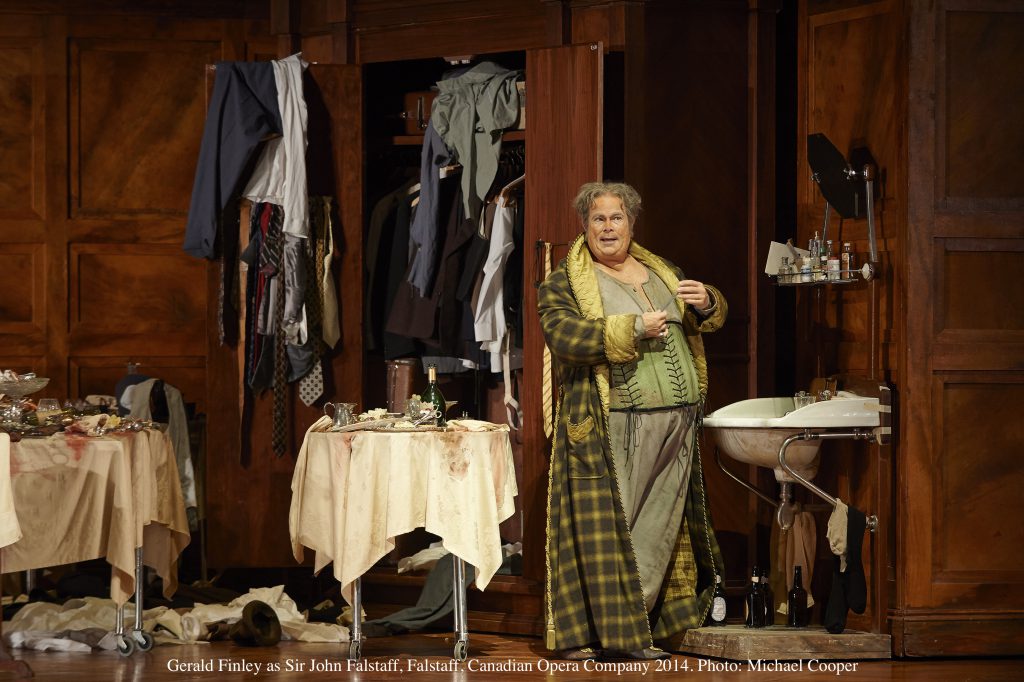Rumours had been buzzing for nearly a year. Finally, on November 27, 1890, the story broke. “A NEW OPERA BY GIUSEPPE VERDI”, trumpeted Milan’s Corriere della sera. The instant the opera world learned it was to be entitled Falstaff, audiences were set tingling. That the great man should again turn to Shakespeare was reason enough for excitement. Otello, Verdi’s previous homage three years earlier, had been electrifying. But this was clearly not to be another tragedy. The news report from the Lombardy capital spoke of a commedia lirica, something the legendary composer had only attempted once before fifty years earlier.
Verdi had not been enthusiastic about the venture at first. Forever haunted by the loss of his first wife and two young children to rheumatic fever in 1840 and facing old age, he had largely withdrawn into retirement when the idea was first presented by friend and publisher Giulio Ricordi. Fashioning a new score suitably expansive enough to frame a largely original Falstaff story would take considerable time and energy, vital ingredients Verdi feared he had in precious short supply. Ricordi was gently persuasive. One look at the outline prepared by librettist Arrigo Boito, the restless talent who had contributed so greatly to Otello’s success, and Verdi’s spirits were promptly revived. A series of increasingly animated letters flew back and forth between the two collaborators and by July 1889, Falstaff, the greatest artistic risk of Verdi’s life, was underway. The ovation that greeted its La Scala premiere was deafening. Verdi insisted the much younger Boito join him onstage as co-creator.
At the age of eighty, Verdi had chosen to round out his long, shining career, not with pessimism and darkness but with inspiration, courage and light.
The Canadian Opera Company launches its Fall 2014 season with a spectacular telling of Verdi’s uproarious tale, big-hearted and buoyant. A co-production with London’s Royal Opera House, Teatro alla Scala, Metropolitan Opera and Dutch National Opera, Toronto-born director Robert Carsen brings his well-travelled production to the city’s Four Seasons Centre stage, creating a Falstaff of enormous vitality. Boito’s rollicking story is gloriously served.
Sir John Falstaff, debauched denizen of Windsor’s Garter Inn, has resolved to end his financial troubles by wooing two of the town’s most formidable matrons, the well-to-do Alice Ford and her friend, Mistress Meg. The laughable strategy grows ever more farcical when the merry wives each receive identical love letters. Alice’s prosperous merchant spouse fumes when he learns of Falstaff’s crass, heedless plan, tipped off by the impoverished old knight’s rebellious unpaid servants, the loutish Bardolfo and Pistola. As outrage and anger blaze, daughter Nannetta steals hidden kisses from her passionate admirer, Fenton. Meanwhile, Ford, Alice and Meg all vow to avenge the blatant insults to their honour.
Falstaff receives word at the Garter Inn via busybody neighbour Dame Quickly that Mistress Ford has eagerly agreed to meet him while her husband is out and about tending to his affairs. Mistress Meg, regretfully, must decline Falstaff’s flattering offer of romance. Her husband never leaves the house. No sooner has Quickly left when Ford appears, disguised as a certain Signor Fontana. He too wishes to win Alice’s favour. Much to Falstaff’s amusement, the wealthy stranger pays him a small fortune to court her.
Reunited at the lavish Ford residence, Alice, Meg and Quickly delight in the thought of springing their trap. Nannetta however is nothing but tears. Her father has announced his intention that she marry his lecherous business associate, Dr. Caius. Alice assures her daughter that Ford will not prevail. Falstaff arrives dressed for courtship. Fortune apparently smiles on the not-so-noble nobleman. Alice welcomes his suit, it seems. Suddenly Ford, rid of his disguise, storms onto the scene very nearly catching Falstaff in the act of seduction. Frantically stuffing her portly suitor into a laundry basket, Alice instructs her domestics to haul the massive hamper to a kitchen window, dumping its contents into the Thames below.
Back at the Garter Inn at sunset, shivering and bedraggled, Falstaff rails against humanity when Dame Quickly arrives for another visit. Mistress Ford, she reports, is more anxious than ever to receive him. He is to meet her that very night in Windsor Forest dressed as the legendary Black Huntsman. Despite a nagging sense of foreboding, Falstaff reluctantly agrees.
Wrapped in shadows, superstitious to the core, the wary old knight creeps into the spooky grove, stag antlers firmly planted atop his head, unaware that Alice has an even bolder act of humiliation in store for him. A band of her allies disguised as eerie spirits torments the trembling rogue. Finally, after much commotion, Falstaff sees through the masquerade. But the game is not done yet. Ford is to officiate at a hallowed woodland rite. The Queen of the Fairies, ably played that night by daughter Nannetta, is to be wed. Alice, with Meg and Quickly’s connivance, presents a second veiled bride. It will be a double ceremony. By the time the solemn proceedings are over, Ford realizes not only has he been tricked into marrying Dr. Caius to Bardolfo but Nannetta and Fenton have been blissfully united. Forgiveness and good humour prevail. Tutto nel mondo è burla. “Everything in the world is a jest,” Falstaff and company agree.
For all its rich Shakespearean heritage, Falstaff is a singularly unique adaptation. Boito’s flair for wringing maximum narrative intensity from his source material, primarily derived from The Merry Wives of Windsor with a passing nod to Henry IV, is everywhere in evidence. Action is sharpened, extraneous subplots eliminated, tension heightened.
As director, Robert Carsen excels in his ability to gauge the precise emotional weight of Boito’s resonant text, delivering it with resounding laughter and poignancy often leaving behind an unmistakable message on stage. Shifting the opera’s timeframe from Elizabethan England to booming 1950s Britain, class and class struggle complicated by gender stereotypes assume recognizably modern dimensions. Breezily shifting perspective back and forth from wide angle to close up, Carsen tirelessly entertains. Witty two-handed repartee gives way to Mack Sennett slapstick scrums replaced, in turn, by moving solos. It is a masterful accomplishment played out on a gorgeous succession of eye-catching sets.
Musically, this Falstaff is no less exciting.
With nearly thirty major operas behind him at the close of his long career, Verdi still clearly had an enormous amount to say. Falstaff ‘s striking through-composed score is characterized by an almost total absence of stand alone arias. The radical structure, despite its modernist flavour, feels less like a turning away from the classic romantic forms the maestro so cherished, more an almost breathless rush to release the wealth of timeless music still surging within him. The effect is inexpressibly thrilling. No sooner is a melody introduced than another even more rapturous theme arrives to replace it. The music flows in a steady stream of consciousness virtually unconstrained, dynamic, acutely human.
Led by its resident principal conductor, Johannes Debus, the superbly nimble Canadian Opera Company Orchestra plays with unparalled dexterity, springing from challenge to challenge with never a hint of discord. From opening pizzicatos to exultant closing chord, a generous openness of orchestral tone and luscious harmony prevails.
As Verdi’s jesterly anti-hero, acclaimed bass-baritone Gerald Finley literally inhabits the title character. Bundled in a blubbery fat suit, swathed in layers of jowly latex, this is a Falstaff of monumental proportions, vocally stupendous and utterly unashamed to exploit every kilo of physical humour in sight. Singing with unwavering precision and expression, Finley’s extraordinary range reaches beyond the limits of merely expansive. We are in the realm of role-of-a-lifetime and Finley is the new king. His intelligence and artistry are unsurpassed. Va’, vecchio John (“Go, old Jack”), Falstaff’s self-declared anthem, is particularly memorable, offered in two very different, brilliantly opposed renditions A snappy song and dance number in Act II sends the old knight courting. A sodden deflated lament in Act III brings him back to earth.
Soprano Lyne Fortin, mezzo Lauren Segal and contralto Marie-Nicole Lemieux are Falstaff’s crafty, worldly-wise trio, Mistress Alice, Mistress Meg and Dame Quickly respectively. Exquisite as ensemblists, splendid as soloists, the two merry wives plus one bring an added air of high spirits to the COC’s sprightly showpiece. Fortin is as earthy and grounded as Segal is sleek and elegant. Lemieux leads Finley’s Falstaff a merry operatic dance, the two physically and vocally circling one another, her Quickly aptly named, bubbling over with sly, wicked humour.
Baritone Russell Braun gives an extraordinary performance as Ford, exasperated, prideful and despairing in turns. Convinced he has been cuckolded, Alice’s neglectful husband, devastated and alone, peers into his soul. È sogno? o realtà? (“Is this a dream or realty”), he despairs. Braun’s delivery of Verdi’s anguished aria is shattering, powerful and impossibly intense.
Lyric soprano Simone Osborne sings a charming, impulsive Nannetta. Frédéric Antoun is a ringing, sure-voiced Fenton. Fellow tenor Colin Ainsworth is Falstaff’s thieving henchman, Bardolfo. Bass Robert Gleadow is his scurrilous retainer, Pistola. A delight to watch in action, the riotous pair of ruffians steal almost as many scenes as they do pieces of Garter Inn silverware. Michael Colvin surmounts the difficult role of the shifty Dr. Caius.
The Canadian Opera Chorus performs with haunting purpose in its single extended appearance as mist-shrouded apparitions in set designer Paul Steinberg’s spare, moonlit woods.
This is a magical production, a euphoric, sparkling Falstaff exclusively populated by an irrepressible cast of all-star Canadian artists. The experience of their joyful, unbounded performances, illuminated by Verdi’s genius, keeps our love of opera alive long after the final curtain falls.


